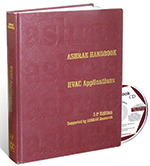
by Brianna Crandall — July 3, 2015—New chapters on smart building systems and moisture management in buildings are included in the newly published 2015 ASHRAE Handbook—HVAC Applications for heating, ventilation and air-conditioning systems.
The updated HVAC Applications volume comprises more than 60 chapters with 1,200 pages covering a broad range of facilities and topics, written to help engineers design and use equipment and systems described in other Handbook volumes. Main sections cover comfort, industrial, energy-related and general applications, as well as building operations and management.
The 2015 edition includes two new chapters:
- Chapter 61, Smart Building Systems, covers smart systems and technologies for automated fault detection and diagnostics, sensors and actuators, as well as the emerging modernized electric power grid and its relationship to buildings and facilities.
- Chapter 62, Moisture Management in Buildings, addresses avoiding or reducing risks associated with damp buildings, with suggestions for architectural and HVAC system design, operation, and occupancy.
Other updates include:
- Chapter 1, Residences, has updated guidance on duct system design and communicating control systems.
- Chapter 4, Tall Buildings, has new content on supertall and megatall buildings; improved stack effect discussion and calculations; and new information on chilled beams, code references, split central plants, and elevator shaft pressurization.
- Chapter 8, Health Care Facilities, has been extensively revised to ANSI/ASHRAE/ASHE Standard 170-2013, Ventilation of Health Care Facilities, with new content on regulatory resources, hospital-acquired infections, sustainability and operations, as well as expanded text on control measures, outpatient care, isolation and bronchoscopy rooms, plus research results from ASHRAE Research Project-1343 on heat gain from imaging systems.
- Chapter 18, Clean Spaces, has extensive new content on demand control, computational fluid dynamics analysis, pharmaceutical manufacturing facilities, safety, environmental systems, installation and testing, and sustainability and energy conservation.
- Chapter 19, Data Centers and Telecommunication Facilities, has been completely rewritten for current best practices as covered in the books of the ASHRAE Datacom Series.
- Chapter 34, Geothermal Energy, has significant new content and examples on ground-coupled heat pump systems design, hybrid ground-source heat pumps, piping, pressure considerations, purging, deep boreholes, central plants, open-loop/surface-water direct cooling, and simulation.
- Chapter 49, Water Treatment, has major revisions on corrosion, deposition, microbiological growth and control, filtration and closed-loop systems, alternative water sources, Legionnaires’ disease, thermal storage and steam boiler systems.
- Chapter 53, Fire and Smoke Control, has been revised to align with ASHRAE’s Handbook of Smoke Control Engineering, and includes many new figures and examples.
This volume is being published in a bound print volume and in electronic format on a CD-ROM, and online, in two editions: one using inch-pound (I-P) units of measurement, and the other using the International System of Units (SI).
The new 2015 volume also is available as one of the four current volumes included in the ASHRAE Handbook Online. Members can subscribe for $33 (list, $289) and get immediate, searchable access to all four volumes in both I-P and SI units.
The cost of either the 2015 ASHRAE Handbook—HVAC Applications (I-P) or 2015 ASHRAE Handbook—HVAC Applications (SI) print bound volume edition, including the CD, is $209. The 2015 ASHRAE Handbook CD, which contains both the I-P and SI editions, costs $189.





